You don’t have to be a farmer to grow your own produce. Even if you live in an apartment, you can give your green thumb a workout with container gardening. All you need is a pot, good quality soil and some sunshine. Container gardens are a lot easier to tend to than traditional gardens, and they yield some amazing results!
How to Start a Container Garden
Are you ready to grow your own herbs, veggies and fruits? Well, you’re in luck! We’ve got simple steps to get you started.
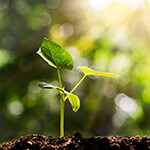
1. Choose Your Location
Some herbs can be grown indoors near a well-lit window, but most plants grow best outdoors. Decks and patios are the perfect place to set up your garden. Once you decide your location, take note of how many hours of sunlight that area gets.
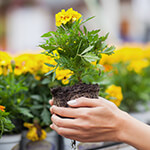
2. Choose Your Plants
Pretty much anything can be grown in containers. Before you grab any plants you want, check the label to see what their sun requirements are and how big they’ll get. Some people like to combine multiple plants in one pot. If that’s your plan, make sure the plants require about the same amount of sunshine and water.
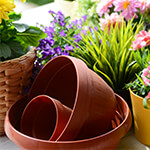
3. Choose Your Containers
Any pot you choose needs to have at least one drainage hole in the bottom. The drainage hole(s) should be at least half an inch for small and medium pots and at least one inch for large pots. Next, you need to consider size, shape and material.
Size
Choosing the right size pot for your plant will ensure that it has room to grow. A good rule of thumb is:
- 24” diameter: summer squash, cucumber
- 18” diameter: cauliflower, small eggplant
- 14” diameter: cabbage and any herb
- 10” diameter: strawberries, small herbs
Shape
Should your pot be deep or shallow, wide or narrow? Most veggies need deep pots to establish their roots. However, some plants, like lettuce, do well in shallow, wide pots where they have room to spread.
Material
There are lots of materials to choose from — terracotta, plastic, concrete and wood to name a few. When choosing your container, keep in mind appearance, durability and weight. For instance, concrete is durable, but extremely heavy. Ceramic looks nice, but cracks easily. Plastic is a favorite because it comes in an array of attractive colors and patterns, and is light-weight as well as durable.

4. Choose Your Soil
The better your soil, the better your plants. Use premium quality potting soil, like Miracle-Gro®, that contains peat moss, compost, perlite, vermiculite and/or rotted manure. You may want to choose soil that has time-release fertilizer mixed in.
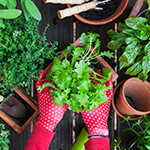
5. Fill Your Pots
Rest your pot on a plant stand or a few bricks (forming a triangle) to assist with drainage. If your pot is heavy, consider placing it on casters for easy moving.
Then:
- Place a coffee filter inside the pot, over the drainage hole(s), to keep soil from leaking out.
- Fill with soil up to one to two inches below the rim.
- Put in your plant and add more soil around it, if needed.
- Water thoroughly, and be sure water is draining through hole.
- Add mulch on top (pine needles, thin bark, straw) to keep moisture in.
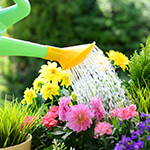
6. Tend Your Garden
Be sure to read your plant labels for the best care instructions. Most plants will need to be watered daily. For best results, water the soil instead of the leaves. Many plants do best with regular fertilizing.
If you’re looking to start your own container gardening with just a few clicks, check out starter kits! Starter kits come with all the necessary items – just plant the seeds, water them, and watch them sprout.
Here are some kits to get you growing:
- This indoor herb garden starter kit includes basil, cilantro, parsley, sage and thyme. It also comes with compostable pots, soil, plant markers, a detailed instruction packet and it’s all certified organic!
- Grow your own fruit at home with this berry starter kit. This kit includes blueberries, blackberries, raspberries and goji berries. This kit also comes with biodegradable pots, soil, labels and detailed instructions.
- Round out your at-home garden with a vegetable starter kit. The basic kit includes carrots, mixed greens, radishes, cherry tomatoes, cabbage and romaine lettuce. There is also a deluxe kit with 12 vegetables and a premium kit with 18 vegetables. This kit also comes with a drip tray, soil, a humidity dome, labels and instructions.
And if you need something to use your new veggies and herbs in – check out our recipes!



